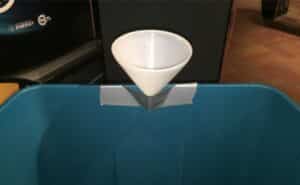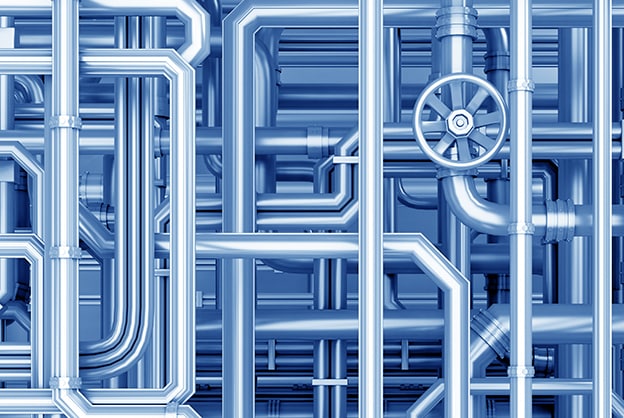Overview
STEM careers
Time
Materials
Per Team:
- 5 PVC pipes, 10′ long and 1″ diameter, cut to varying lengths (6″, 9″, and 12″)
- Various 1″ PVC fittings: tees, wyes, 90 ̊ angles, 45 ̊ angles, cross tees, couplings, and so forth (3–4 of each fitting per team, or about 10 of each for public use)
- Water source
- 2–3 pitchers
- Funnels (2 per team, or 10–20 for public use)
- Large plastic bin
- Towels
- Duct tape
- Saw to cut PVC
- Optional for indoors: Plastic tarp, mop, “wet floor” signs
Relevant Terminology
Pipeline: A line of connected pipes used for carrying liquids or gases over a long distance.
Pressure: The continuous force exerted on one object (like the inside of a pipe) by something in contact with it (like the water inside of it).
PSI: Pounds per square inch. A unit of pressure measured in force (pounds) exerted on a given surface area (square inch). Water flowing through a pipe can create a lot of pressure, and engineers have to have a way to measure that pressure.
Water pressure: A force that affects the rate at which water flows. The greater the pressure, the faster the water flows.
Introduce
GETTING READY
This activity is best done outdoors. Indoors, you may choose to place a plastic tarp on the floor and have a mop and “wet floor” signs available.
The plastic bin will be the end point for the pipe maze. You can easily accommodate several teams at once by attaching funnels around the rim of the bin. Use duct tape to hold the funnels in a position that allows them to drain into the bin.
Create multiple starting points by taping funnels to chairs, tables, or other structures around your activity area. All pipe runs must end at one of the funnels in your bin. Make sure there is enough room for the funnel spout to connect with a pipe.
You can buy PVC pipe in 10-foot lengths. Carefully cut each pipe into smaller lengths; for example, 6, 9, and 12 inches.
INTRODUCTION

A high-pressure water pipeline being installed at NASA’s Stennis Space Center. Credit: NASA.
Ask questions of participants to determine what they know about pipes and water systems:
- Are all pipes the same size or material? Why or why not?
- Have you ever seen a water leak in your house? If so, where was it?
- What are some other kinds of pipes that might leak? What problems could happen as a result?
A leaky oil pipeline can have huge ecological consequences and cost mil- lions of dollars in cleanup and repair. Engineers design safety devices such as automatic shutoff valves to help prevent such a catastrophe.
Instructions
Introduce the design challenge. Participants will work in small teams to build a pipe system that directs water to a designated point without leaking.
- Assign each team a starting point and an end point for their pipe system.
- You may choose to distribute a limited amount of materials to each team or allow free access to materials.
 Allow participants to freely experiment with different designs. Encourage discussion in each team. When the team thinks their system is ready, test it with some water.
Allow participants to freely experiment with different designs. Encourage discussion in each team. When the team thinks their system is ready, test it with some water.
- Use a pitcher to pour water into the starting point and watch for leaks.
- You can decide if you’ll allow participants to pour their own water or if you’ll pour it yourself.
- Identify any leaks. Encourage the team to redesign their system and try again.
Evaluate the success of each design.
- Did the system transport water from the starting point to the end point?
- Did the system leak?
ACTIVITY VARIATIONS
Provide additional challenges to older children, such as:
- Place the starting point farther away from the plastic bin
- Only provide fittings with more than two holes
- Limit the number of fittings that can be used
- Design the pipes to circumvent an obstacle (chair or other object)
- Build a pipe system that combines flow from multiple starting points
This activity can be used to address local pipe/pipeline topics, such as:
- Gas/oil pipelines
- Irrigation
- Water pipelines/aqueducts
TROUBLESHOOTING
If water leaks out of a fitting, make sure the pipe and fitting are connected tightly. Also check the fitting for cracks.
Guiding questions
GUIDANCE FOR YOUNGER CHILDREN
QUESTIONS TO ASK AFTER THE ACTIVITY
- Did your system carry the water from the starting point to the ending point without leaking?
- If your system did leak, what did you do to fix this problem?
- Did all of the water that entered your pipeline come out at the other end? Why or why not?
- What challenges did you come across while building your pipeline?
GUIDANCE FOR OLDER YOUTH AND ADULTS
QUESTIONS TO ASK AFTER THE ACTIVITY
- Were you able to transport 100% of the water from the starting point to the ending point? Why or why not?
- What factors must engineers consider when designing a pipeline?
- What forces were acting on the water to move it?
- If there were leaks, where do you notice most of them occurred?
- Would changing the size of pipes that you were using affect the water pressure? Explain.
- As you added more pipes to your system, what happened to the water pressure? Can you explain this?
Engineering & science connections
GUIDANCE FOR YOUNGER CHILDREN
Engineering Connections
Have you ever wondered what happens to the water when you flush the toilet? The answer is that it travels through a series of pipes to a local water treatment facility. Sewage systems, like other water systems, use a connected series of pipes. The pipes carry water from homes and businesses to a facility where the dirty water can be treated to remove any waste.
Why is it so important to clean dirty water? For one thing, water is a very important resource. Without clean drinking water, we would die in just a couple of days! So we must value every drop and protect our water supplies. Some engineers are responsible for making sure that the pipes that bring clean water to our house and take dirty water to treatment plants don’t leak and lose our valuable water. But we have to do better. The average household’s leaks can total more than 10,000 gallons of water per year. That’s 270 loads of laundry!
Science Connections
Why do pipes and other parts of a water system leak? Reasons include bad connections between pipes, worn components like the flushing mechanism in a toilet, dripping faucets, and corroded piping. Corrosion is a kind of damage where the pipe can slowly be eaten away. It is caused by a chemical reaction between the material from which the pipe is made, usually metal, and the water that flows through it or the soil in which it is buried. Over time, this corrosion causes the walls of the pipe to get thinner and weaker. Eventually the walls become so thin that the water can begin to leak from inside the pipe into the surrounding environment. To fight this problem, engineers now use pipes made from materials that resist corrosion, like plastic or concrete, for newer water systems. By reducing the amount of corrosion and leakage, engineers are working to protect our water resources for future generations.
GUIDANCE FOR OLDER YOUTH AND ADULTS
Engineering Connections
Water pipes are critical to a lot more than getting water to and from houses and businesses. The average household pushes about 2 gallons of water per minute through a half-inch pipe, but some water systems, like the Space Launch Systems at the Stennis Space Center, require about 335,000 gallons of water per minute! Water is a vital component for rocket launch testing, and engineers are busy replacing the 50-year-old piping system that is currently in place. The original design was only built to produce 300,000 gallons of water per minute at a pressure of 300 psi (pounds per square inch).
The new piping that is being added to this water system is made of carbon steel and is lined on the inside and outside with a material that will prevent corrosion. Engineers also added a pump that would increase the water flow by 25,000 gallons per minute. The engineering and design principles that went into the planning and building of this tremendous water system are without compare, and when the test day arrives, this system will pump out in 18 seconds the same amount of water that an average household uses in a year!
Science Connections
Water pressure is a term used to describe the strength of the flow of water traveling through a pipe or system. The more water that is pushed through a pipe, the greater its pressure. In order to maintain the level of water pressure in your home, water systems require both pumps that create pressure and water storage tanks that rely on gravity to convey water to homes or businesses. The greater the pressure within a pipe, the more likely it is to spring a leak. Large pipes, called water transmission mains, which carry water under high pressure to entire communities must be made from strong materials such as steel, ductile iron, pre-stressed concrete, or high density polyethylene.
Activity created by Liberty Science Center. All rights reserved.
Supplemental content adapted for Dream Big Activities by the Carnegie Science Center.


0 Comments